Songwriters at any level are always looking for that perfect series of chords that will strike a chord, so to speak, with their audience.
Pop music, in particular, is brimming with shared chord progressions that listeners find instinctively familiar and alluring.
Mastering these tried and tested progressions is a must for any serious songwriter.
No matter your musical background or the specific style within which you compose, these building blocks can serve as guiding lights.
They can stimulate creative ideas, form the backbone of a powerful hook, or add nuance to your harmonies.
Our aim is to compress these musical compass points into a digestible format for immediate application in your songwriting process.
Table of Contents
- Essential Pop Chord Progressions
- I-IV-V-IV (1-4-5-4)
- ii-V-I (2-5-1)
- I-IV-V (1-4-5)
- vi-iii-V-ii (6-3-5-2)
- V-iii-IV-I (5-3-4-1)
- I-vi-ii-V (1-6-2-5)
- I-vi-IV-V (1-6-4-5)
- I-V-vi-iii-IV (1-5-6-3-4)
- I-V-ii-iii (1-5-2-3)
- ii-V-I-IV (2-5-1-4)
- VI-iv-i-V (6-4-1-5)
- I-IV-ii-V (1-4-2-5)
- vi-IV-ii-V (6-4-2-5)
- I-vi-IV-ii (1-6-4-2)
- I-ii-V-I (1-2-5-1)
- I-iii-IV-vi (1-3-4-6)
- I-vi-ii-vi (1-6-2-6)
- The Bottom Line
Essential Pop Chord Progressions
I-IV-V-IV (1-4-5-4)
This fundamental progression gives pop music its catchy, uplifting edge.
The I-IV-V-IV chord progression is a fundamental formula in pop music, enhancing a track’s catchy quality with its rhythmic predictability and harmonic richness. It’s especially useful for songwriters as it provides a perfect framework for creating a compelling melody, and it’s versatile, giving the ability to create a variety of moods depending on the pacing and instrumentation of the song.
- Difficulty: Easy
- Example: G – C – D – C (Key of G major)
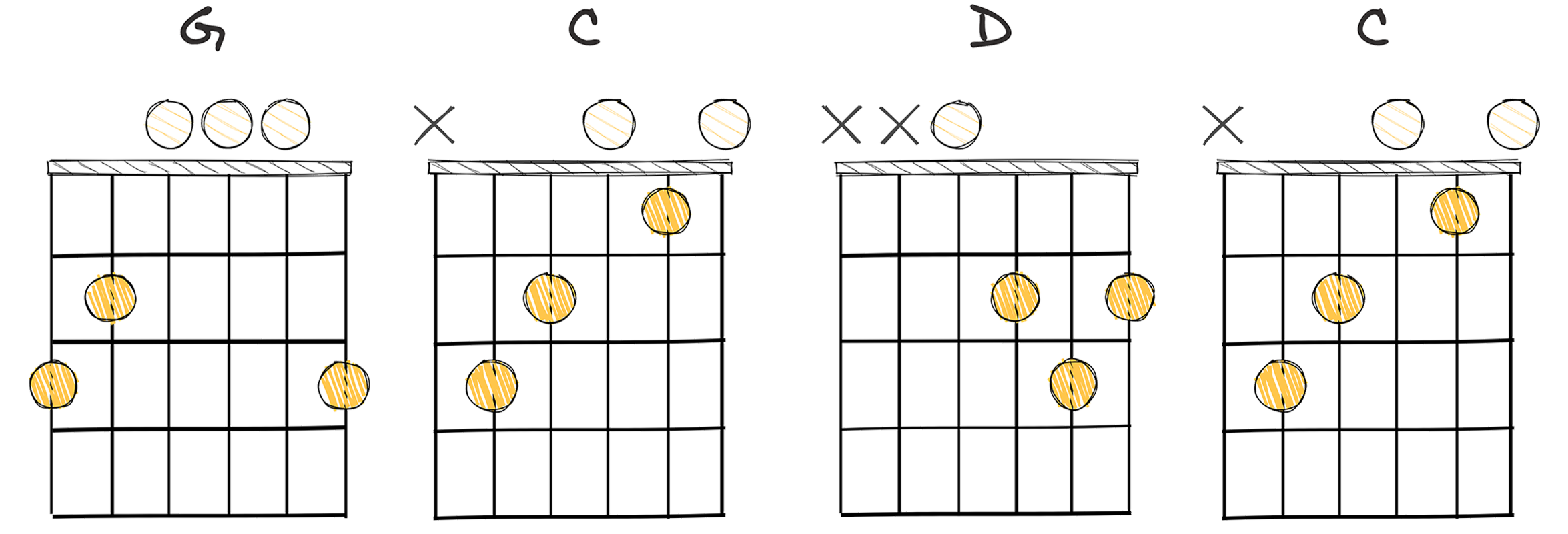
When discussing pop chord progressions, one cannot overlook the historical importance and integral role the I-IV-V-IV (1-4-5-4) progression has played.
Often categorized under the ‘easy to play’ section, this progression is popular among both budding songwriters and seasoned artists alike for its simplicity and the compelling sound it provides.
It’s like a magic recipe for a hit pop song.
The progression’s history is rich with countless chart-topping hits from various genres and era.
Its timeless appeal lies in its versatility, with its ability to establish a solid harmonic base making it a favored choice in different music styles.
In the key of C Major, we see the progression represented as C – F – G – F, and it is this precise arrangement of chords that contributes to the song’s powerful impact.
What’s fascinating about the I-IV-V-IV progression is its ability to create a sense of tension and release, a critical aspect in engaging the listener emotionally.
It’s this dynamic progression that allows the melody to return to the root note in the end, bringing a sense of closure to the phrase.
Moreover, for budding songwriters, this progression’s simplicity makes it a great starting point.
It’s like a musical sandbox waiting for your unique creative touches.
Not only does it provide an ideal structure for a song, but it also serves as a reliable framework to experiment with different melodic lines and rhythmic patterns.
Most importantly, this progression reminds us that sometimes simplicity is the key to creating memorable and impactful music.
Understanding and mastering the I-IV-V-IV (1-4-5-4) progression is more than just learning a series of chords; it’s about tapping into a universal language that has the potential to resonate with listeners across the globe.
ii-V-I (2-5-1)
The quintessential chord sequence fueling countless pop melodies.
The ii-V-I progression, also known as a 2-5-1, is a classic sequence used extensively in pop, jazz, and classical music due to its satisfying resolution and smooth voice leading.
- Difficulty: Easy
- Example: Em – A – D (Key of D Major)
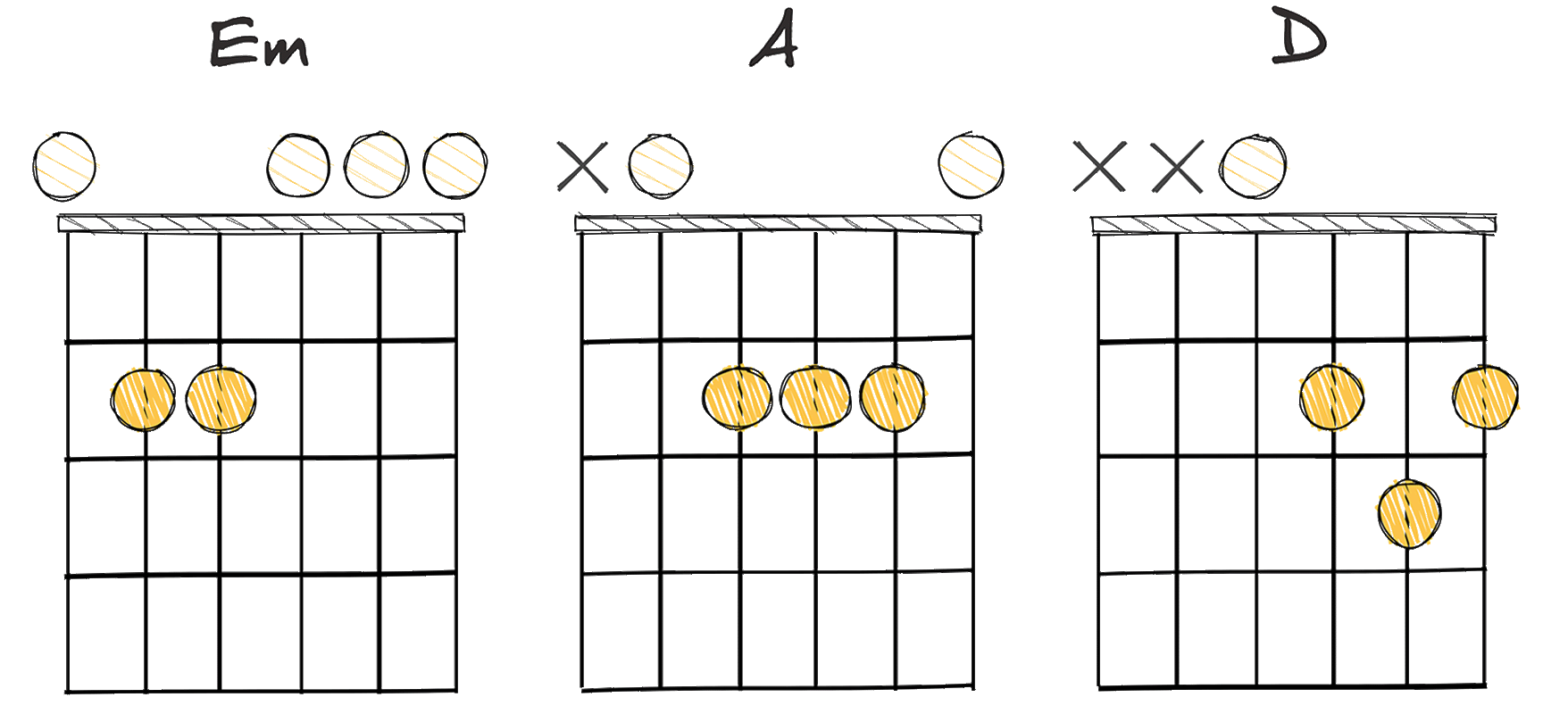
The ii-V-I (2-5-1) chord progression is a mainstay of many popular music genres, especially in pop music.
Dating back several decades, it has managed to stay relevant due to its smooth tonal movements and ease of play.
It is often referred to as the “perfect cadence” because of its strong resolution and satisfying conclusion.
What’s more, despite its complexity, tens of thousands of songwriters find it easy to play.
Musicians of all skill levels can incorporate this progression into their music with relative ease.
The ii-V-I’s simplicity doesn’t equate to being mundane; it brings a unique blend of melodious complexity and satisfying resolution that makes it appealing to listeners’ ears.
This progression’s uniqueness has made it a favorite tool for songwriters in both pop and other music genres.
It has been used in countless hit songs, adding depth and structure.
This is proof of how the ii-V-I progression’s varying note combinations can result in many different musical flavors.
Even though the ii-V-I progression is old, it is in no way outdated.
It continues to be a powerful tool in the hands of skilled songwriters.
It is an essential solution for anyone looking to understand and master the intricacies of pop music songwriting.
This progression offers an endless array of possibilities for melodic development, making it a valuable addition to any songwriter’s toolkit.
I-IV-V (1-4-5)
This classic, upbeat progression is the backbone of pop music.
The I-IV-V progression, or the 1-4-5, is a basic and classic chord progression used extensively in pop music. Known for its simplicity and catchy sound, it has been a cornerstone for many iconic pop songs, making it an essential tool for any songwriter.
- Difficulty: Easy
- Example: G – C – D (Key of G major)
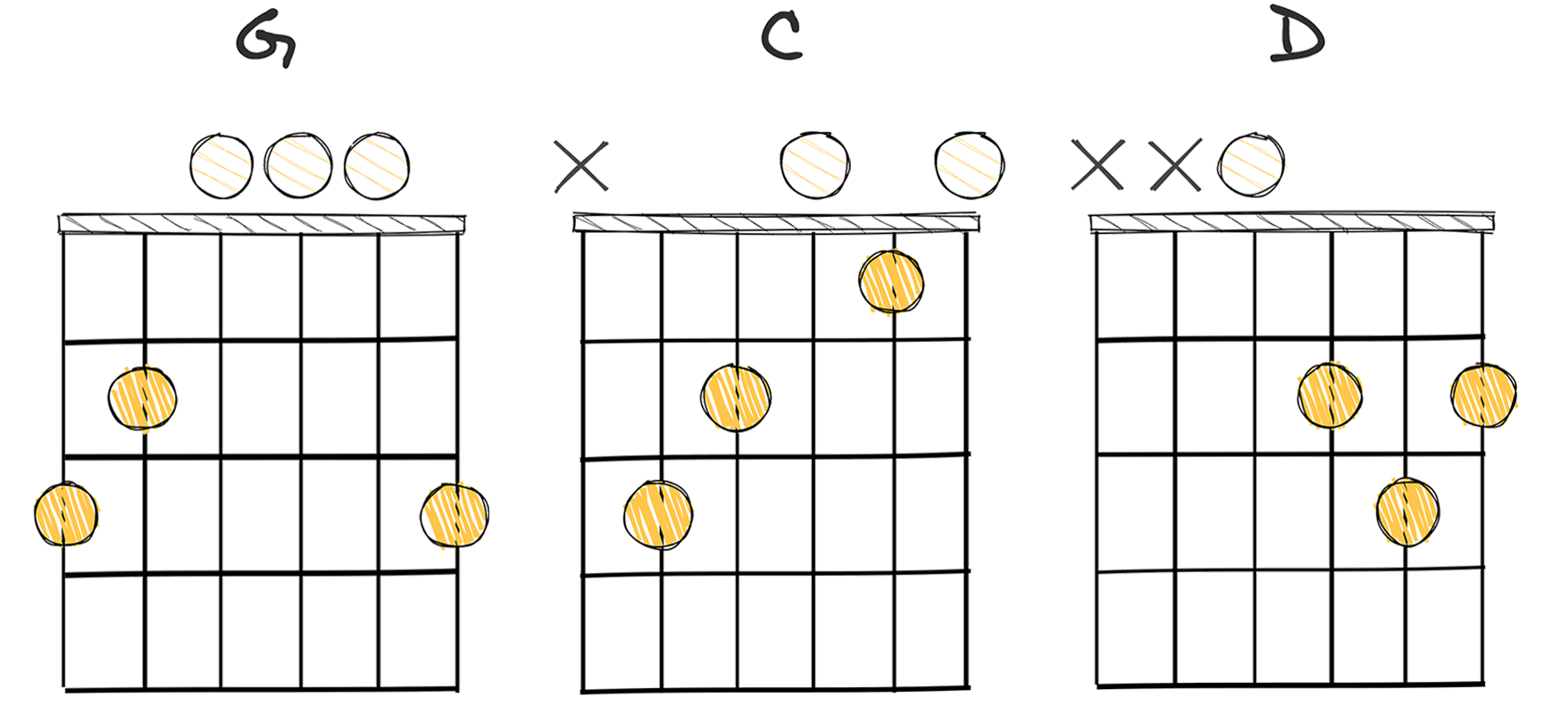
The I-IV-V chord progression is a tried and true standard in the pop music genre.
This progression, with its simplicity and feel-good tune, has been a part of the pop music fabric for decades.
Essentially, this chord progression is a series of three chords.
Played in the key of G major, these chords would be G (I), C (IV), and D (V).
What makes this progression so essential to pop music is its ease of play.
It is notably straightforward to execute, making it a great starting point for beginner musicians.
This ease of play does not, however, make it any less impactful.
The I-IV-V progression is behind some of the most popular and instantly recognizable songs in pop music history.
The I-IV-V progression is a reminder that complexity is not a prerequisite for music that moves people.
In many ways, its beauty lies in its simplicity.
Historically, this progression has roots deep in the traditional music of many cultures.
It’s foundational to the blues genre as well as folk music, further cementing its importance in popular music.
The historical significance and universal resonance of the I-IV-V progression make it a staple in songwriting.
It’s a sort of common language among musicians, one that transcends genre and style.
Understanding this progression equips any songwriter with a reliable tool for creating catchy, memorable songs.
In the grand tapestry of pop music, the I-IV-V chord progression holds a place of honor.
It’s a testament to the power of simplicity and the importance of tradition in music.
The next time you’re listening to your favorite pop song, tune into the underlying chords.
You may just discover the unmistakable sound of the I-IV-V progression echoing through the record, a testament to its timeless appeal.
Indeed, the I-IV-V progression exemplifies how basic chords can create complex emotions, and how popular music continues to rely on this reliable and versatile progression.
Undeniably, the power of the I-IV-V chord progression is a force to be reckoned with in pop music and beyond, serving as a foundational building block for many of the world’s most loved songs.
vi-iii-V-ii (6-3-5-2)
Weaves a path from longing to hope, forming a complex yet accessible emotional landscape often found in pop music.
The vi-iii-V-ii progression, using the chords Am – Em – G – Dm in C major, creates a captivating blend of emotions. The sequence moves from a melancholic start to a moment of brightness, then returns to a softer finish. This progression is like a brief emotional journey, often found in pop music, that resonates with a mixture of longing and hope, weaving a complex yet accessible musical narrative.
- Difficulty: Easy
- Example: Am – Em – G – Dm (Key of C major)
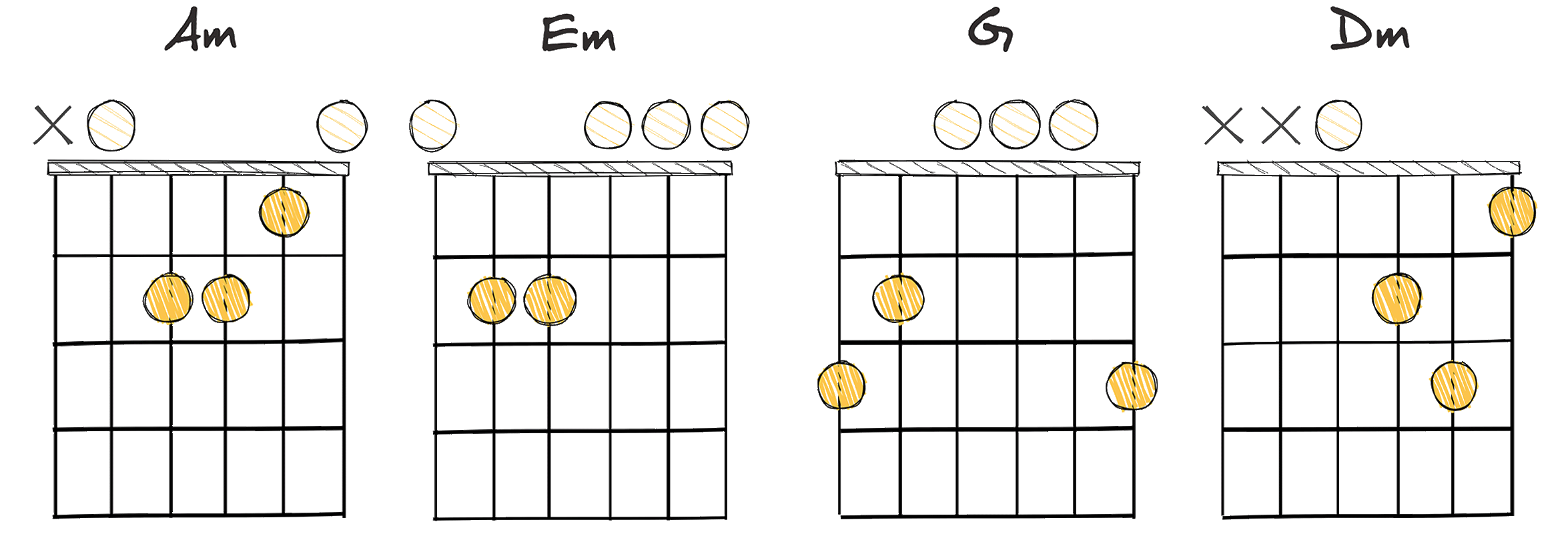
The chord progression vi – iii – V – ii (6-3-5-2), as exemplified by the chords Am – Em – G – Dm in the key of C major, holds a significant place in pop music, often surfacing in songs aiming for an expressive and heartfelt sound.
Unlike the rustic feel often attributed to other progressions, this sequence provides a contemporary, emotional vibe that fits impeccably within the lively and dynamic nature of the pop genre.
The history of the 6-3-5-2 progression is deeply interwoven with the evolution of modern popular music.
The roots of this chord progression reach into the heart of popular music, resonating with listeners due to its natural flow and emotional accessibility.
Its attractive quality lies in its innate musicality, creating a cohesive melody that’s both approachable and profound.
Many musicians, whether classically trained or self-taught, have found inspiration in this progression, leveraging its innate ability to elicit a broad spectrum of emotions.
The enduring appeal of the 6-3-5-2 progression has ensured its continued prevalence in today’s pop music, solidifying its status as a fundamental element in the genre’s musical lexicon.
This modern icon allowed an expansive degree of musical articulation for pop artists, even those at an intermediate level.
The progression’s flexibility has made it a favorable choice for various vocal textures and musical contexts, broadening its allure even further.
From a creative standpoint, approaching the 6-3-5-2 progression is more than adhering to a pattern; it’s about embracing a musical instrument to enrich the emotional resonance of your compositions.
This perspective invites endless creative exploration, particularly when crafting contemporary songs that align with the pop tradition.
Its universal appeal and emotive power have made the vi-iii-V-ii progression a fundamental building block in the world of pop, fostering a connection between the artist and the audience in a uniquely engaging way.
V-iii-IV-I (5-3-4-1)
This progression conveys a journey from boldness to reflection, ascending to hope, and settling into resolution, a unique blend in pop music..
The V-iii-IV-I progression (G – Em – F – C) in C major unfolds a melodious story, starting with the strong declaration of G major, slipping into the reflective Em, ascending to the hopeful F major, and resolving in the comforting embrace of C major. It’s a journey from strength to resolution, imbuing pop songs with an intriguing complexity..
- Difficulty: Easy
- Example: G – Em – F – C (Key of C major).
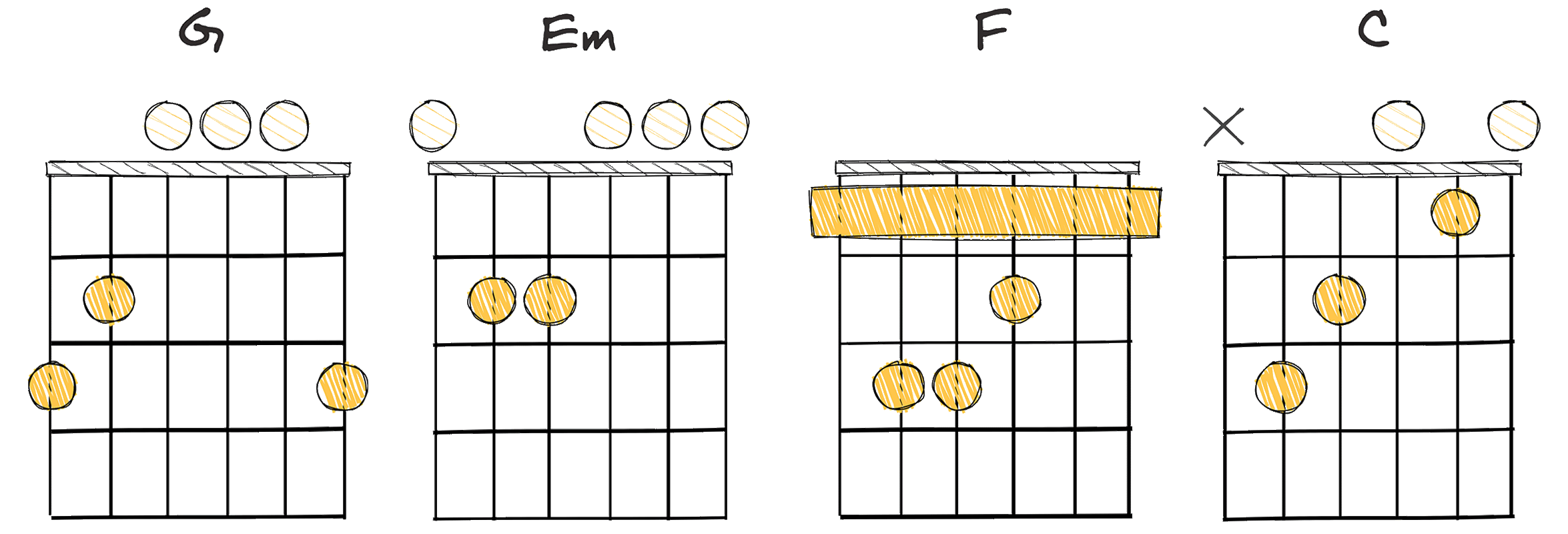
As we explore the progression that’s next on our list, namely the V-iii-IV-I (5-3-4-1), we should highlight that it’s an increasingly favored chord sequence in pop music.
This particular chord progression has found its way into various compositions due to its emotional depth and musical fluidity.
As such, diverse artists across genres have discovered the allure of this progression in crafting memorable tunes.
Incorporating the V-iii-IV-I progression can add a poignant and reflective quality to your music, rendering a sound that’s both introspective and resonant to listeners.
Essentially, it’s a distinctive pattern in its own right, characterized by the chords G – Em – F – C in the key of C major.
Moreover, the progression’s smooth flow makes it a prime choice for pop music, contributing to a unified and engaging musical narrative within a song.
In terms of playability, the V-iii-IV-I progression typically consists of readily accessible chords on guitar or basic formations on a piano, making it approachable for musicians of different abilities.
Historically speaking, while it may not be as longstanding as other progressions, it’s certainly gaining traction in modern music.
This progression, woven into contemporary pop hits, represents a fresh take on chord sequences that resonate with today’s audience.
Critically, the relative complexity of the V-iii-IV-I progression adds a layer of sophistication without compromising accessibility.
I-vi-ii-V (1-6-2-5)
A universally versatile progression infusing numerous pop songs with timeless charm.
The I-vi-ii-V chord progression is a classic sequence used in numerous pop songs due to its versatile and appealing sound. This progression creates a looping pattern that offers a harmonious blend of major and minor chords, making it a crucial tool for any songwriter’s repertoire.
- Difficulty: Intermediate
- Example: F – Dm – Gm – C (Key of F major)
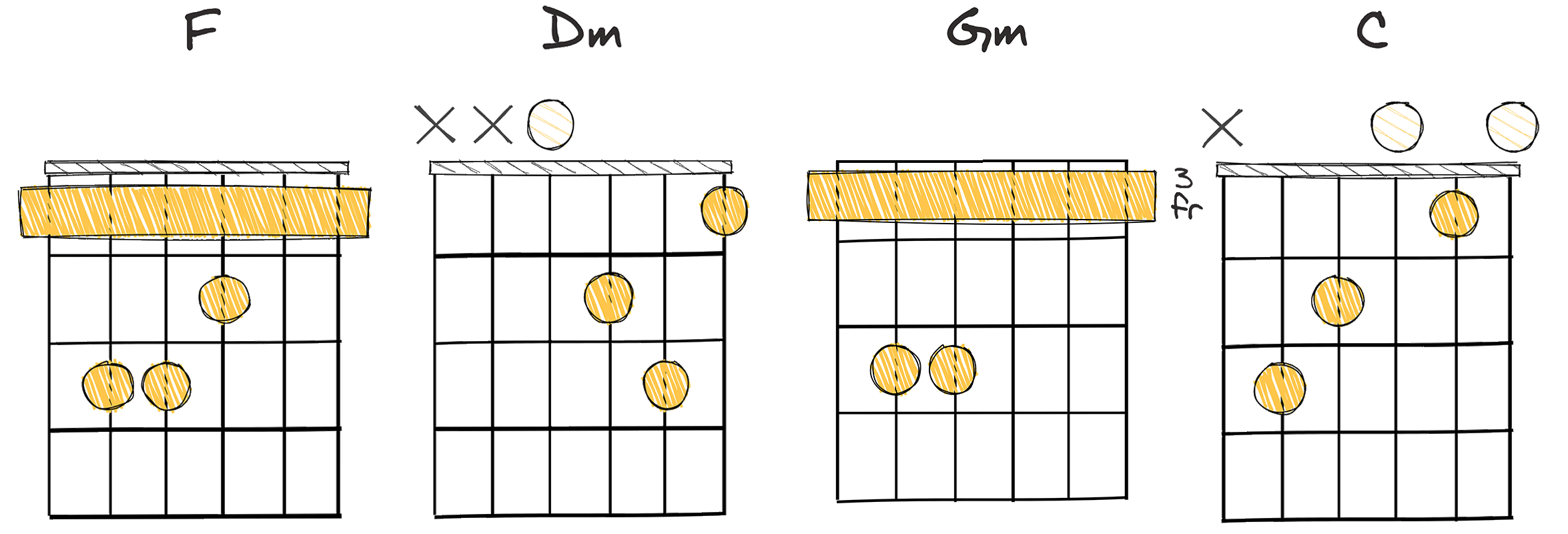
If we were to talk about chord progressions that are both prevalent and vital in pop music, the I-vi-ii-V or 1-6-2-5 progression certainly warrants a discussion.
This progression, commonly found in intermediate levels of play, provides the opportunity to add a sense of movement and dynamism to the music.
The inherent beauty of the I-vi-ii-V progression lies in its capacity to strike a balance between tension and resolution—a cornerstone of all musical expression.
The 1-6-2-5 progression is a staple in genres ranging from pop to jazz, with its roots tracing back to the baroque era.
Sepaking to this, the lineage of the I-vi-ii-V or 1-6-2-5 progression dates back to the baroque era, where it was often used to create satisfying harmonic progressions.
It eventually found its way into pop and jazz, genres where it continues to be a foundational element.
This progression, in the key of C major, translates to the chords: F – Dm – Gm – C.
This sequence propels the piece forward, advancing the song while also grounding it.
The I-vi-ii-V progression’s expansiveness allows composers to craft intricate melodies that retain listener interest.
Its prevalence in pop music, historically and currently, speaks volumes about its appeal.
The combination of the I – vi – ii – V progression provides a balance that resonates with the human ear, creating a pleasing melodic line that appeals to the listener.
In wrapping up this section, it’s important to remember that the art of songwriting often involves recognizing and employing the right chord progression.
Being well-acquainted with, and skillful in the application of the I-vi-ii-V progression can be a key factor in a songwriter’s ability to construct successful and emotive songs.
I-vi-IV-V (1-6-4-5)
The ubiquitous I-vi-IV-V: a timeless backbone of countless pop hits.
The I-vi-IV-V progression, also known as the ’50s progression, is a hallmark in numerous popular songs throughout history given its catchy and harmonious arrangement. It begins with the home key, then moves to the related minor, transitions to the subdominant, and finally, to the dominant, creating a cycle that delivers a sense of resolution, making it a perfect choice for catchy pop music.
- Difficulty: Easy
- Example: G – Em – C – D (Key of G major)
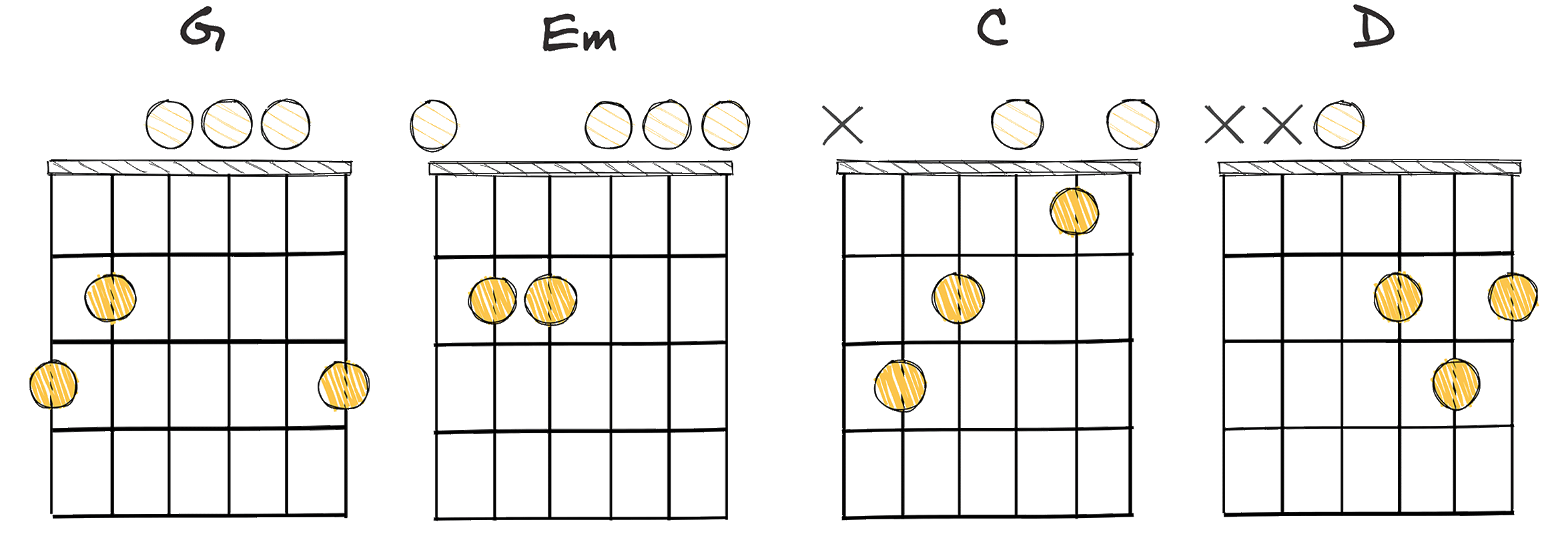
The I-vi-IV-V chord progression, denoted numerically as 1-6-4-5, is a staple in pop music.
This catchy and memorable progression is a classic that has been used extensively in pop music since the 50s.
This iconic progression’s simplicity and versatility make it a crucial tool for any songwriter to have in their repertoire.
Digging into the reasoning behind its success, one might notice how this progression evokes a sense of satisfying resolution and completeness.
There is a natural tension and release built into these four chords that resonates with listeners on many levels.
Moreover, the I-vi-IV-V progression is typically easy to play, allowing musicians of all skill levels to utilize it in their compositions.
Switching between these chords tends to be physically uncomplicated on most instruments, which has contributed to its widespread use.
As for the historical aspect, this four-chord pattern dates back to classical music but has since been adapted into virtually every musical genre.
You can find it in rock, pop, country, R&B, and many others, making it truly a universal chord progression.
Ultimately, the beauty of the I-vi-IV-V progression lies in its ability to convey a variety of moods.
It can elicit feelings of joy, sorrow, longing, or serenity, depending on how songwriters choose to present it.
For instance, if you’re working in the key of G major, the I-vi-IV-V progression will translate to G – Em – C – D.
The I-vi-IV-V progression is an indisputable stalwart in the pantheon of pop music.
Knowing how to use it will not just facilitate songwriting but also enable you to better understand and analyze the music of others.
I-V-vi-iii-IV (1-5-6-3-4)
Master this progression for a seamless flow of pop melody.
This is a popular chord progression that provides an emotional and resonant sequence, often used in pop music. It features a satisfying resolution with its transition from the dominant fifth to the minor sixth, leading to the less common minor third, before resolving on the fourth.
- Difficulty: Intermediate
- Example: G – D – Em – Bm – C (Key of G major)

One of the most popular chord progressions is the I-V-vi-iii-IV, otherwise known as the 1-5-6-3-4 progression in numeric terms.
This progression, which seems intermediate in terms of difficulty, is rich in harmonic interest and serves as an interesting deviation from the more common song structures.
The 1-5-6-3-4 progression has been used in many popular songs, its distinctive progression creating a unique musical landscape that provides a refreshing change from regular chord sequences.
The use of the iii chord, which isn’t often found in popular music, provides a unique sense of tension in the sequence that elevates the emotional impact of the song.
Interestingly, even with its level of complexity, this progression remains a favorite among musicians looking to incorporate a greater depth of emotion into their compositions.
The progression’s history is not as well-documented as other more widely used sequences, but its influence is undeniably significant in shaping the direction of pop music.
Being introduced to popular music through well-known acts like The Police, the 1-5-6-3-4 progression showed that pop music can break away from its traditional structures and experiment with different chord sequences for a fresh sound.
Consequently, the I-V-vi-iii-IV progression shaped a new wave in pop music composition, as it inspired musicians to explore different harmonic combinations.
This progression, with its complex and unique structure, is an excellent tool for songwriters looking to bring diversity and experimentation into their music.
With its intriguing tension and release pattern and its ability to set a unique emotional tone, the 1-5-6-3-4 progression truly is an essential chord sequence for any songwriter aiming to create an unforgettable musical piece.
As such, understanding and mastering this progression, along with many others, can significantly enhance a songwriter’s ability to create meaningful and captivating melodies.
I-V-ii-iii (1-5-2-3)
A strong yet melodious flow, leading from confidence into a soft, emotive finish, often used to narrate a story in pop music.
The I-V-ii-iii chord progression in C major, manifested as C – G – Dm – Em, exudes a melodious and engaging sound. Starting strong with the root, it cascades through a dominant fifth into a softer minor sound, culminating in an emotive finish. Its flow creates a narrative-like feel in pop music.
- Difficulty: Easy
- Example: C – G – Dm – Em (Key of C major)
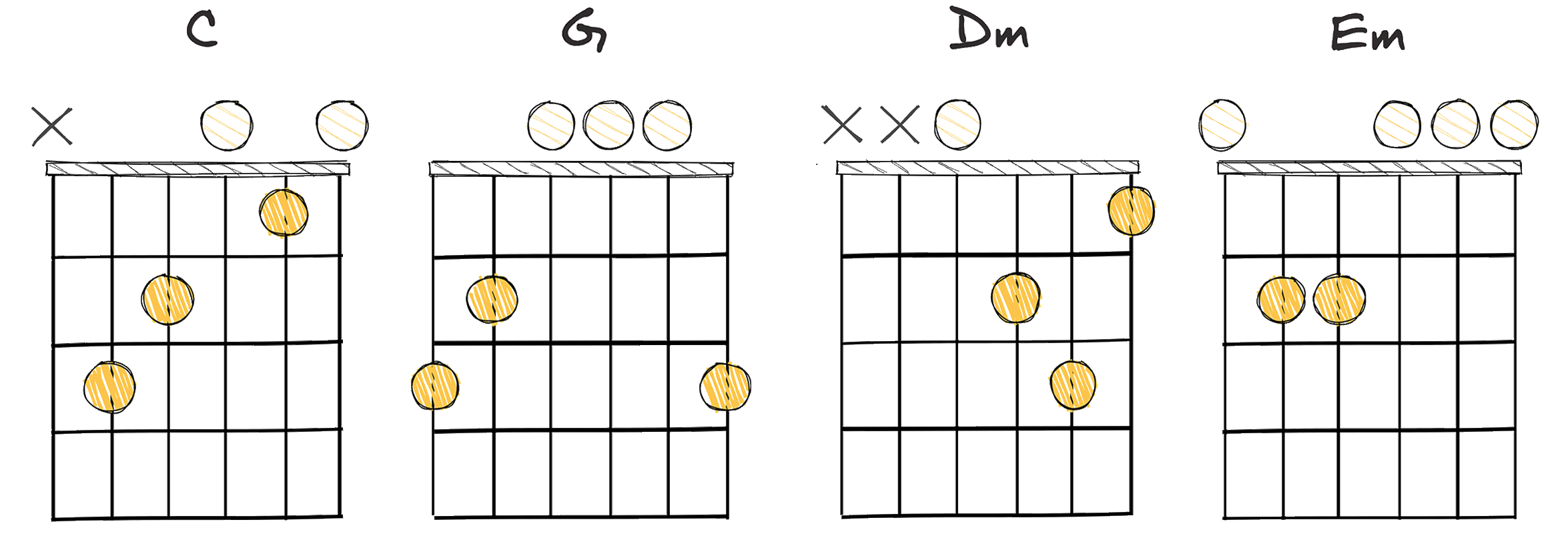
The chord progression I-V-ii-iii plays a vital role in popular music, resonating with a timeless quality that makes it not only frequent but also incredibly adaptable.
This section will explore the enthralling universe of the I-V-ii-iii chord progression, focusing on its background, how it’s implemented in songs, and why it’s a crucial knowledge piece for songwriters.
Renowned for its versatility, this chord progression is a cornerstone in numerous cherished pop tunes.
The progression commences with the I chord (the root), advances to the V (fifth) chord, then transitions to the ii (second) chord, and finally settles with the iii (third) chord.
The I-V-ii-iii chord progression, though somewhat more complex than the conventional four-chord progression, still offers a spectrum of melodic opportunities, threading a fine balance between familiarity and innovation.
Its popularity has its roots intertwined with the evolution of pop music, persisting as a dynamic influence on contemporary works.
This progression is approachable to play, making it a favored choice for both budding songwriters and skilled musicians honing their art.
Historically, it’s been integral to myriad successful songs across various styles, attesting to its broad allure and adaptability.
This chord progression can be realized in the key of C major, translating to the chords C – G – Dm – Em.
The I-V-ii-iii chord progression stands as an invaluable asset for songwriters of all skill levels, owing to its intricate harmonic structure paired with an intuitive playability.
Undoubtedly, embracing and mastering this progression can profoundly enrich a songwriter’s musical arsenal.
This progression represents a nuanced fragment of the pop music framework, and its ubiquity underscores its lasting charm and decisive function in pop music composition.
ii-V-I-IV (2-5-1-4)
A foundation stone of numerous pop classics.
The ii-V-I-IV chord progression is a staple in popular music genres due to its harmonious and resolved feel, providing a simple but effective base for many different melodies. Its structure allows for a dynamic and energetic build-up, incorporating a common jazz turnaround with a seamless transition to the IV chord, making it a versatile and essential tool for any songwriter.
- Difficulty: Easy
- Example: Dm – G – C – F (Key of C major)

As we delve into songwriting, understanding the importance of the ii-V-I-IV progression is essential for composers and musicians of all genres, not just pop music.
Throughout the years, the ii-V-I-IV progression has made its mark in the history of music, becoming one of the most common chord sequences in pop culture and jazz.
Not just limited to the jazz scene, the ubiquitous ii-V-I-IV progression has also found its place in pop music, adding momentum and creating musical depth in a composition.
The progression’s use in this track contributes to its catchy tune and the timeless appeal that has kept it relevant even years after its initial release.
But, what gives the ii-V-I-IV progression its unique character?
It lies in the tension and relaxation created by the progression.
While it starts with a subdominant minor chord, it then moves on a dominant chord, which builds the tension.
Finally, it resolves to a tonic chord, folllowed by a subdominant chord, which provides the relaxation.
In the key of C Major, the ii-V-I-IV progression is represented by Dm – G – C – F.
It is clear that this progression is not only common but also, in its own way, versatile.
This flexibility allows songwriters and composers to add their unique spin, creating a myriad of songs across genres using the same fundamental sequence.
Playing the ii-V-I-IV progression is relatively straightforward for even the budding musician.
It inspires creative experimentation with different rhythm patterns, melody lines and harmonic content, all while maintaining a familiar tonal foundation for listeners.
Therefore, the ii-V-I-IV progression can be deemed as an indispensable tool in the songwriter’s toolbox.
All in all, taking a deeper look into essential pop chord progressions like ii-V-I-IV will undoubtedly enhance your music skills, whether you’re penning your first songs or truly mastering the craft of compositions.
VI-iv-i-V (6-4-1-5)
This quintessential pop progression embodies an emotive, catchy resolution.
The VI-iv-i-V chord progression is popular in pop music, characterized by its ability to loop seamlessly, which adds to its catchy rhythm. It conveys powerful emotions and leaves lots of room for artists to have unique possibilities when it comes to melody and rhythm.
- Difficulty: Easy
- Example: G – Em – Bm – F# (Key of B minor)
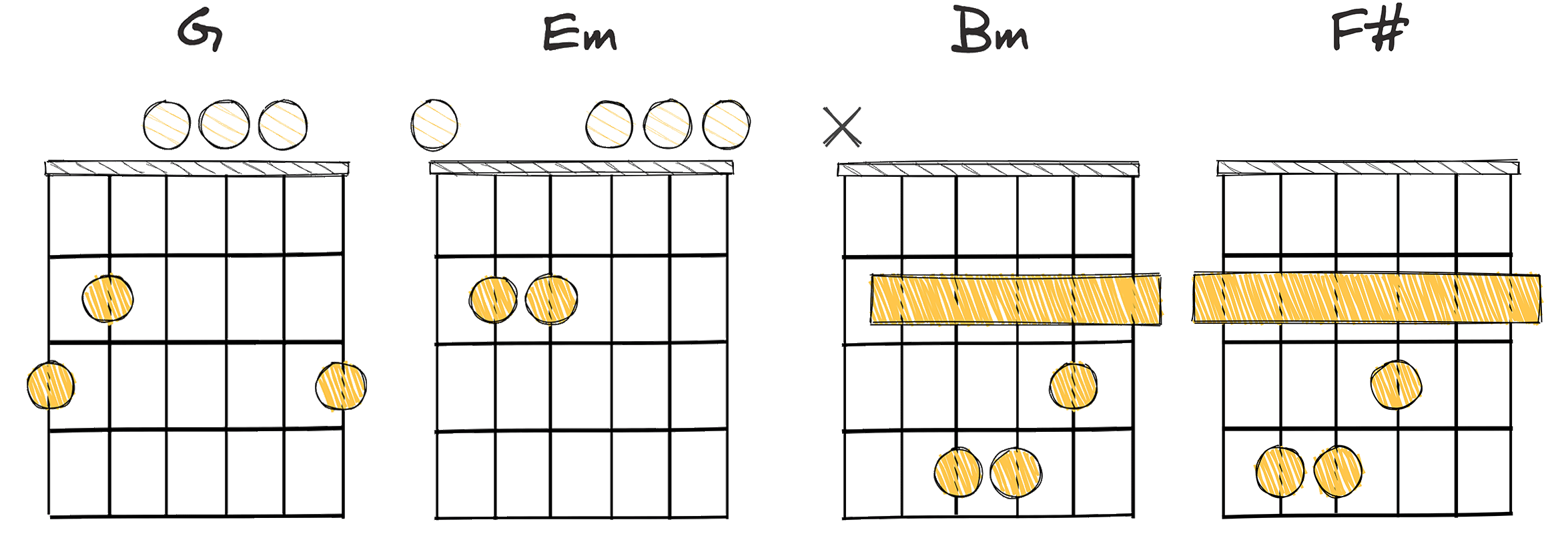
The chord progression VI-iv-i-V is one that is essential for any aspiring songwriter, especially those dabbling in genres like pop, rock, or folk.
This progression is very commonly utilized, and there’s a good reason for that.
The natural flow of musical tension and release inherent in this movement of chords creates a satisfying and catchy melody that people can’t help but enjoy.
Also, it’s important to note that this particular progression is quite easy to play, especially on instruments like the guitar or piano; this makes it accessible to even beginner songwriters.
In terms of the progression’s history and application,
The VI-iv-i-V has been a staple in popular Western music for decades.
This is particularly true in the realm of pop music, which relies heavily on memorable, repeated chord progressions like this one.
Being easy to play and highly recognizable, this progression has found its way into countless pop songs.
Listeners might not always consciously recognize this progression, but they will often feel familiar with a song that employs it because of its frequent use in popular music.
I-IV-ii-V (1-4-2-5)
A timeless, flexible progression underpinning countless pop melodies.
The I-IV-ii-V chord progression is a staple in the songwriting industry, often used due to its natural, pleasing sound that is easy on the ears. This progression creates a harmonious circle of chords, making it a favorite among pop musicians to add a touch of familiarity and catchiness to their music.
- Difficulty: Easy
- Example: D – G – Em – A (Key of D major)
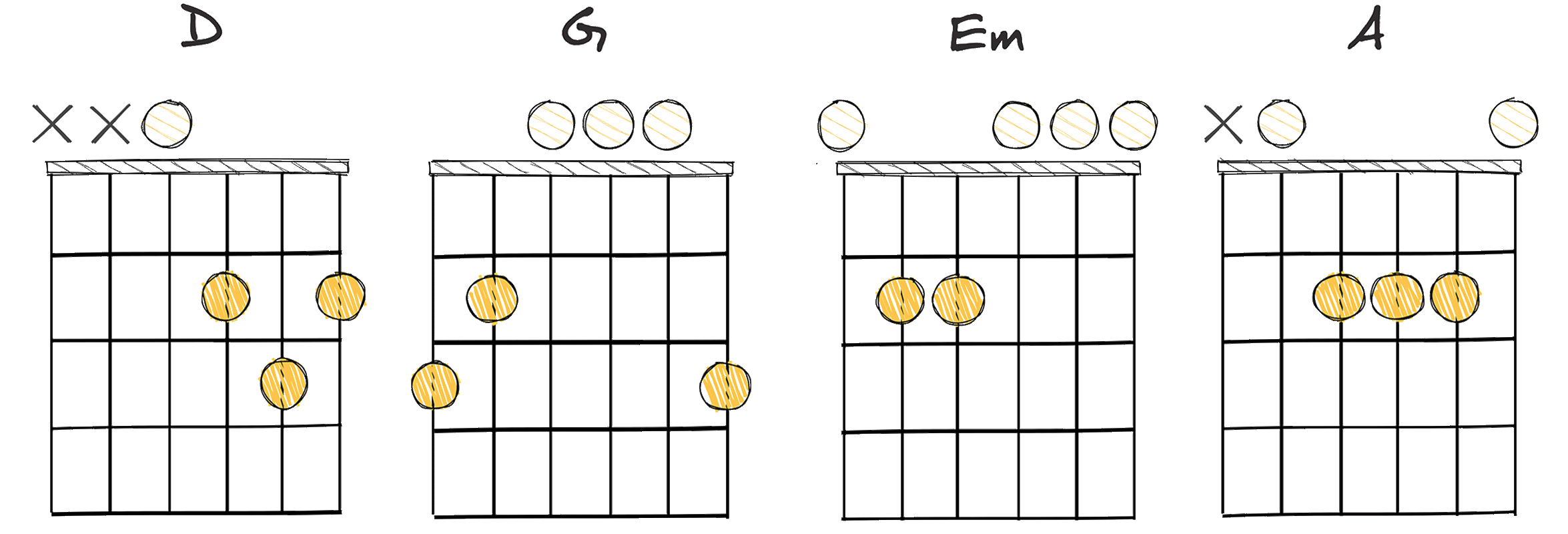
When you dive into the world of songwriting, one of the core concepts every songwriter should be familiar with is chord progressions.
Among the diverse array of chord progressions available, the I-IV-ii-V (1-4-2-5) is an essential progression in the realm of pop music.
Historically speaking, the I-IV-ii-V (1-4-2-5) chord progression is a variation of the II-V-I (2-5-1) progression.
This minor modification helped it find acceptance in the pop genre, becoming a key fixture in several popular tracks.
The beauty of the I-IV-ii-V progression lies in its simplicity and versatility, easily meshing with a range of musical styles.
Supporting this assertion is the fact that it offers a pleasing melodic movement for the listener, creating a smooth, cyclical flow.
It blends the perfect mix of major and minor chords, providing a balance of happy and melancholic feelings that is a trademark of pop music.
Moreover, the I-IV-ii-V progression is considered relatively easy to master on various musical instruments.
It bears a straightforward structure that can be moved up and down the fretboard or keyboard with minimal difficulty.
If we consider the progression in the key of D major (an example given earlier), we get the chords D – G – Em – A.
Quite interestingly, numerous pop songs employ this combination.
Getting a grasp on the I-IV-ii-V progression empowers songwriters to dissect the mechanics behind a vast number of pop songs.
This understanding can serve as a solid foundation for penning your own catchy tunes.
The use of chord progressions such as the I-IV-ii-V progression not only facilitates the creation of engaging melodies, but also contributes to the accessibility of music for both the musician and the listener.
Once mastered, this versatile progression can be a potent tool in the arsenal of any budding or experienced songwriter.
With it, you can navigate your way through the labyrinth of melodic creation, setting the stage for unforgettable original compositions.
In conclusion, understanding chord progressions, specifically the I-IV-ii-V (1-4-2-5), can bolster your songwriting skills and knowledge, giving you a creative edge in an ever-evolving world of music.
vi-IV-ii-V (6-4-2-5)
A timeless progression, delivering emotional depth in numerous pop tunes.
The vi-IV-ii-V chord progression, also known as the 6-4-2-5 progression, is a popular pop music staple that is highly valued for its dramatic and dynamic structure. It is cherished by songwriters as it provides an interesting twist on the popular IV-V-vi progression while still maintaining a familiar, catchy feel.
- Difficulty: Intermediate
- Example: Am – F – Dm – G (Key of C major)
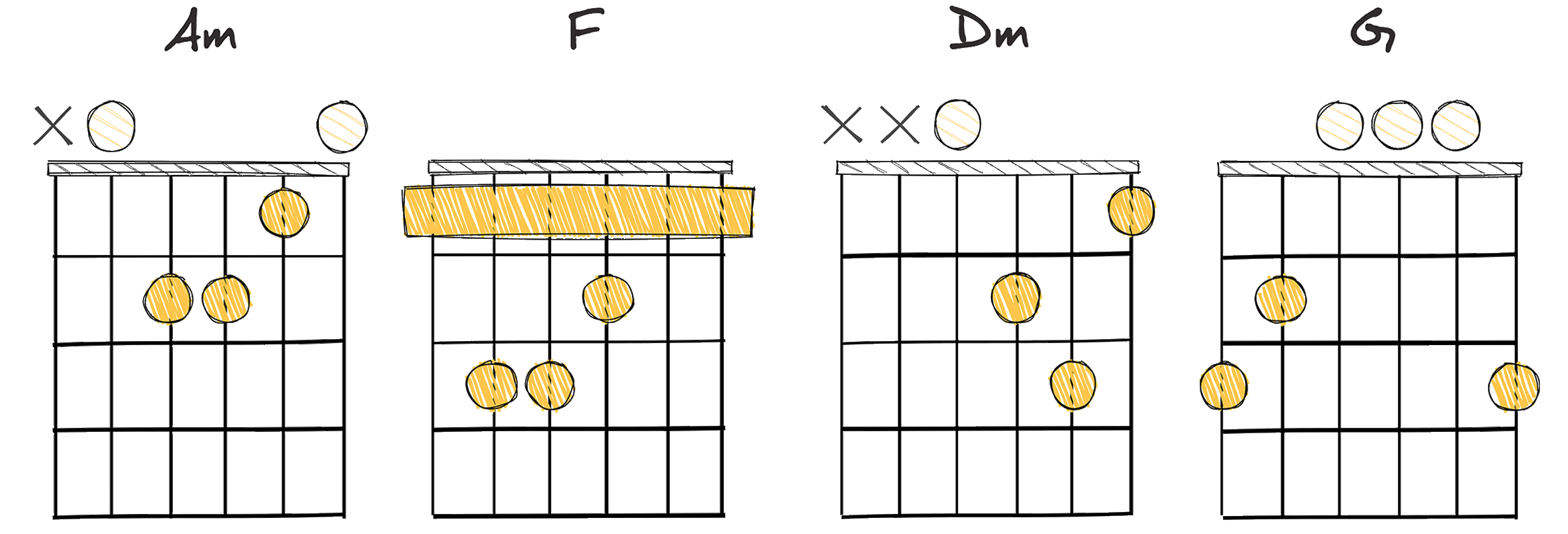
When delving deep into the realm of popular musical arrangements, there are certain chord progressions that are essential to understand, one of which is the vi-IV-ii-V, or the 6-4-2-5 progression.
This particular sequence is notable for its integrated use of minor and major chords, lending itself perfectly to creating songs with unique emotional impact.
While it is not as commonly observed as the I-IV-V, it holds its own distinct place in the toolbox of skilled songwriters.
Being an Intermediate level progression, a thorough understanding of this sequence can immensely help boost the quality of creative expression in songwriting.
In terms of history, this chord progression shares its roots with jazz and has been adopted extensively into pop music.
Its origin in jazz brought about a distinct level of sophistication and flexibility in composing songs.
Given its minor-major chord alternation, it creates a signature musical tension and resolution within the progression, generating a more profound connection with the listeners.
In the key of C major, these chords translate to Am – F – Dm – G.
When played in this order, you fully emulate the nuanced style of the vi-IV-ii-V chord progression.
It is no coincidence that some of the most memorable songs in pop history have harnessed the power of this chord progression.
Its ability to transport the listener on an emotional journey – from tension to resolution – paves the way for more expressive and impactful songwriting.
As a songwriter, mastering this progression offers unlimited artistic potential and can provide exciting new avenues in your musical narratives.
Overall, the vi-IV-ii-V chord progression represents an indispensable element of the pop music formula, proven time and again by countless hit songs’ time-tested success.
I-vi-IV-ii (1-6-4-2)
A go-to progression providing melancholic nuance to pop ballads.
The I-vi-IV-ii progression is a classic staple in pop music, providing a smooth and resonate sequence that is pleasing to the ear. It’s a versatile pattern that can fit a variety of song moods, including joyful, poignant, or contemplative, making it a vital tool for songwriters in creating diverse and appealing compositions.
- Difficulty: Intermediate
- Example: G – Em – C – Am (Key of G major)
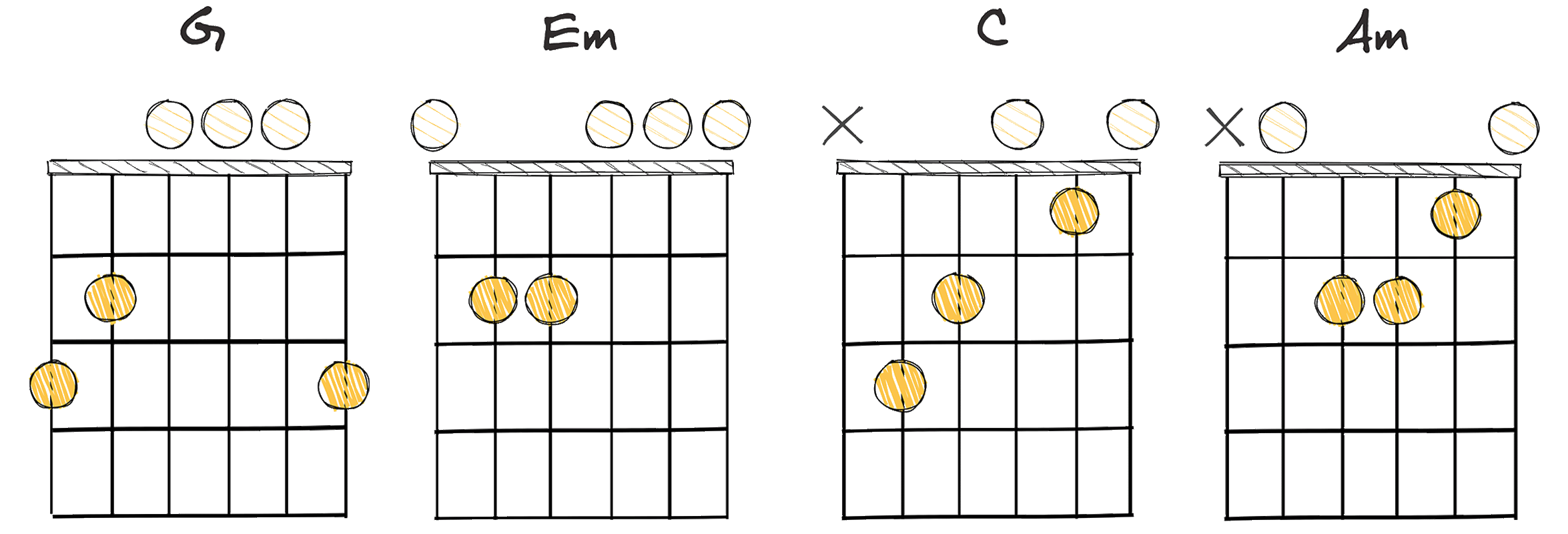
What makes the I-vi-IV-ii (1-6-4-2) chord progression stand out among the several chord progressions is its unique blend of major and minor chords.
This progression strikes a perfect balance between high and low emotional tones.
Historically, this progression can be traced back to the classical era and was frequently used in the works of renowned composers such as Mozart and Beethoven.
It was popularized in the twentieth century by songs in various genres, from rock and pop to jazz and blues, which firmly grounded it in the mainstream music landscape.
Although it might be considered as an intermediate progression to play, many aspiring songwriters and musicians can easily grasp it with practice.
The progression moves from the tonic or the ‘home’ chord, to the relative minor, then to the subdominant, and finally to the supertonic.
With this, it becomes a tool for creating tension and release in the music, while also providing a solid structure for a song.
The musical journey created by these chords help to evoke the emotional resonance the song is famous for.
Moreover, even without the lyrics, this progression alone manages to communicate a sense of hope and solace.
It’s a testament to the versatility and emotional depth that this four-chord progression can convey.
The I-vi-IV-ii (1-6-4-2) chord progression has lent itself to countless memorable songs across decades and genres.
I-ii-V-I (1-2-5-1)
A harmonious backbone in countless pop songs.
The I-ii-V-I progression is a fundamental sequence in pop music, known for its smooth and pleasing resolution. It plays a key role in driving the harmony of a song, offering an easy transition between chords while retaining a melodic fluidity.
- Difficulty: Easy
- Example: D – Em – A – D (Key of D major)
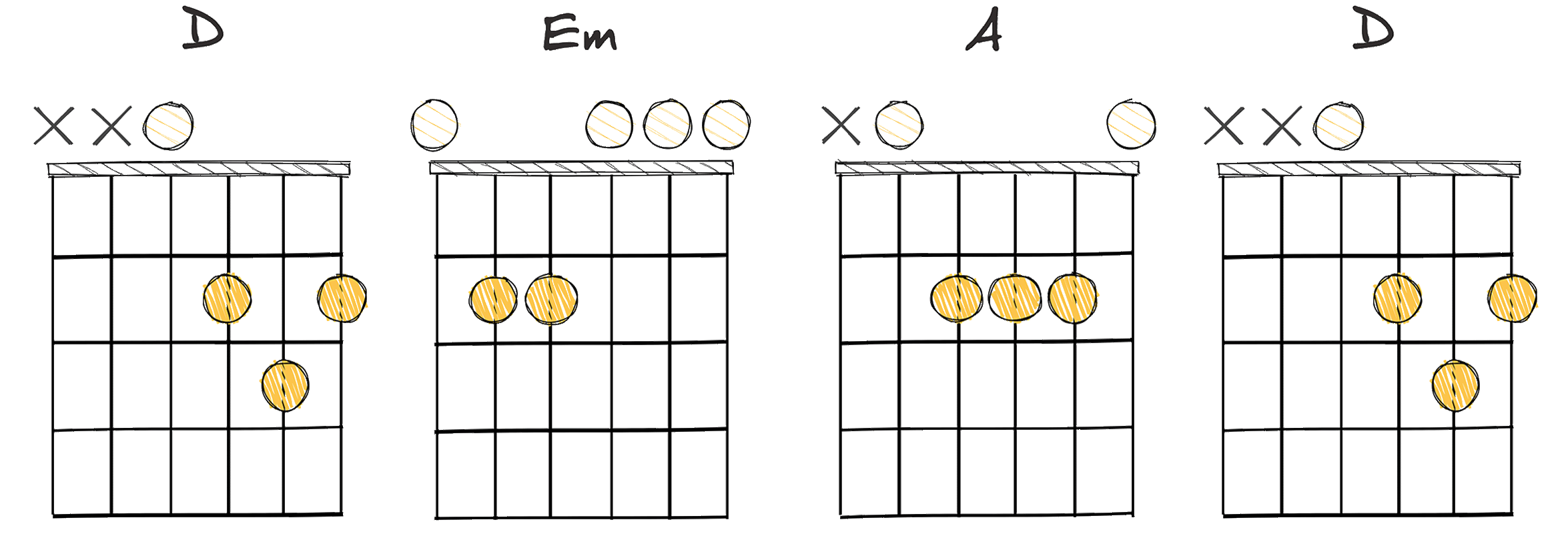
Delving into the chord progression I-ii-V-I, also known as 1-2-5-1, we unearth a staple in pop music with a common appeal.
This progression, despite its ubiquitous nature, remains relatively simple to play, therefore, encouraging beginners to experiment with it.
As such, it unleashes a myriad of musical possibilities, becoming a foundation upon which many popular songs are built.
Notably, the chord progression I-ii-V-I is a classic in jazz, as it is frequently used in many of its standard tunes.
One could argue this progression is adored in pop music for its uncomplicated structure that allows for a smooth flow and easy transition.
Also, due to its cyclic nature, it blends perfectly with a multitude of other progressions, allowing for a seamless chain of chords that forms a beautiful musical piece.
The ease of playing this progression, combined with its recurring pattern, makes it an ideal choice for artists and songwriters who often rely on it to create catchy songs.
In relation to its history, the I-ii-V-I progression can be traced back to classical music, adding an undeniable charm due to its rich historic roots.
This chord progression is not only cherished by pop musicians but it is also a favorite among jazz artists, as it forms the fundamentals of most Jazz standards.
The chords in this specific progression, can be exemplified in the Key of D major as D – Em – A – D.
By using these chords, songwriters manage to create memorable melodies that resonates with a myriad of listeners.
Knowing this chord progression and mastering its concept is valuable for every songwriter, as it forms the backbone of countless memorable pop songs.
As we continue to delve into the nuances of other chord progressions, we’d notice that, the understanding and application of I-ii-V-I undoubtedly strengthens a songwriter’s magic touch.
I-iii-IV-vi (1-3-4-6)
A poignant, frequently used progression for captivating, melancholic pop songs.
This I-iii-IV-vi (1-3-4-6) chord progression is fundamental to pop music, driving the melody and creating a catchy, upbeat sound. It’s often used by songwriters to craft memorable hooks and choruses, adding an emotionally charged underpinning to the lyrics.
- Difficulty: Intermediate
- Example: G – Bm – C – Em (Key of G major)
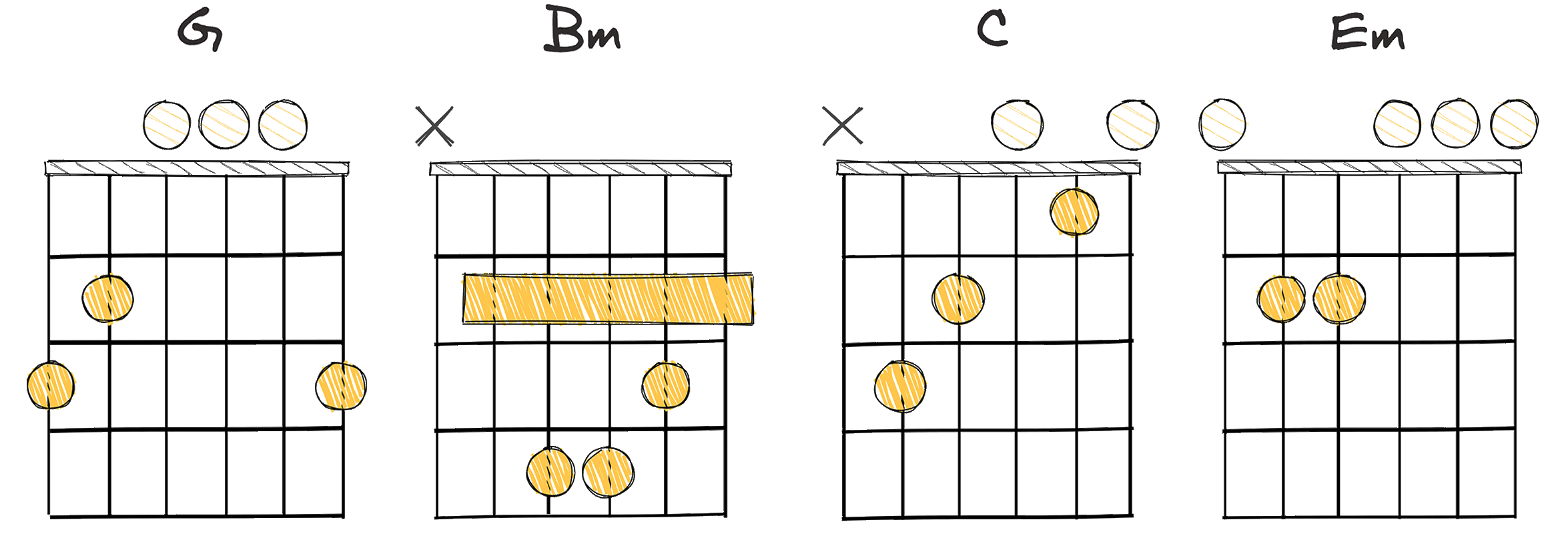
The I-iii-IV-vi (1-3-4-6) chord progression is one that offers a significantly unique tone compared to others.
Usually found in various pop music genres, this progression holds an intermediate level of difficulty for learners.
It’s primarily due to the inclusion of the III which can be a major or minor chord, and it adds a distinctive flavor to this progression.
This melodic progression serves as the musical backbone of the track.
Nevertheless, the I-iii-IV-vi progression offers a range of combinations to experiment with, allowing songwriters to produce unique and memorable melodies.
For example, in the key of G major, this sequence can be played as G – Bm – C – Em.
When these chords are played in this order, it brings out the inherent melodic richness of this key, making it an appealing choice for songwriters.
Although it has been utilized abundantly, the I-iii-IV-vi progression is not just a ‘quick fix’ to writing catchy tunes.
It demands a deep understanding of harmonic structures and chordal relationships to be effectively embedded into a song’s arrangement.
We can’t overlook the fact that it takes time, practice, and a good grasp of basic musical theory to master such intermediate progressions.
Yet, when you understand its intricacies, the I-iii-IV-vi progression can become an essential tool in your songwriting repertoire.
Remember, the beauty of this progression lies in its flexibility and the potential for creating varied and nuanced melodies.
One final point, if you listen closely to the recordings of many great pop songs, you’ll hear this progression coming up time and time again, offering a gently shifting harmonic foundation beneath the surface of the melody.
I-vi-ii-vi (1-6-2-6)
A gentle, reflective harmony that resonates with both brightness and melancholy, perfect for soul-stirring melodies..
The I-vi-ii-vi progression in G major, with chords G – Em – Am – Em, creates a harmonious and reflective sound. It weaves a gentle emotional journey, offering a balance between brightness and melancholy. This progression adds depth to a song, making it suitable for soulful ballads and contemplative pop melodies.
- Difficulty: Easy
- Example: G – Em – Am – Em (Key of G major)
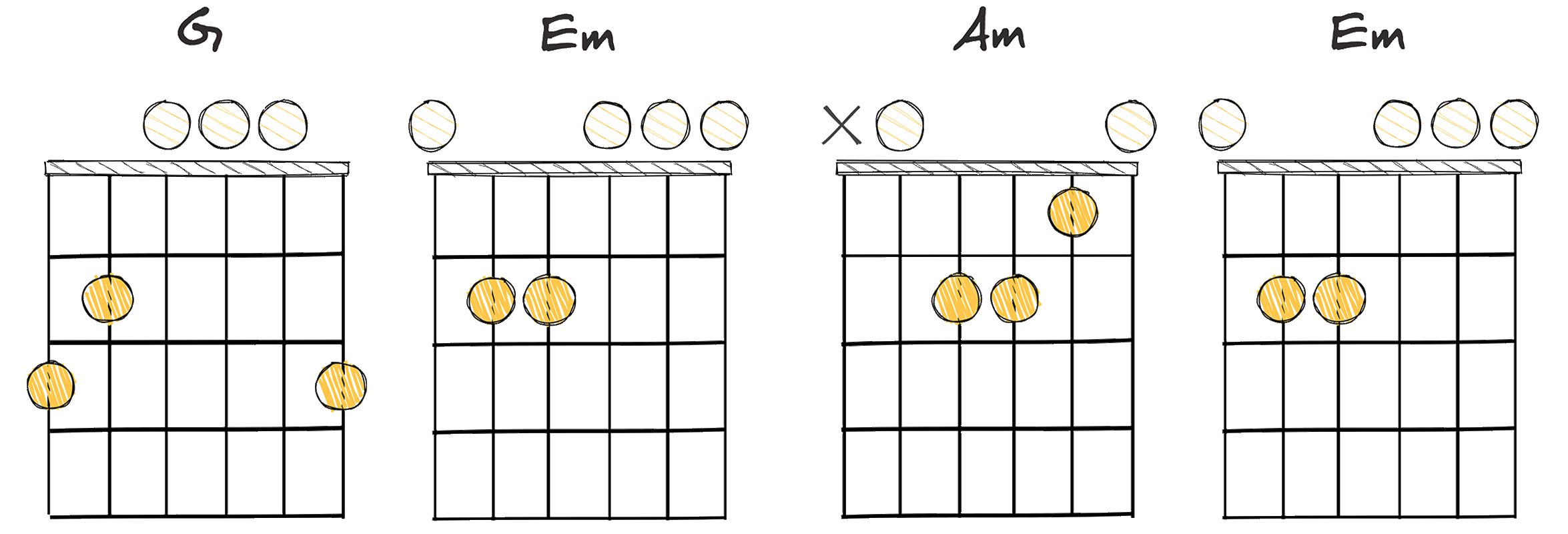
The I-vi-ii-vi (1-6-2-6) chord progression is a captivating tool that resonates deeply within the sphere of pop music.
Known for its enchanting and emotive capacity, this progression has graced many chart-topping hits, marking its importance in pop music’s rich tapestry.
This chord progression commences with the First Degree of the scale (I), ventures into the melancholic Sixth Degree (vi), explores the reflective Second Degree (ii), and returns to the Sixth Degree (vi), weaving a narrative that’s both harmonious and full of expressive depth.
The G – Em – Am – Em in the key of G major serves as a prime example, offering a fluid musical pathway that’s relatively simple to play yet imbued with a subtle complexity that can capture both the novice ear and the seasoned professional.
Its cyclical nature allows for a sense of balance and emotional exploration, while still holding onto a core identity, making it a preferred choice among contemporary songwriters and performers.
The structure gives the music a gentle ebb and flow, providing an inviting canvas for melodies to dance and interact with listeners.
In essence, the I-vi-ii-vi progression’s combination of accessibility, musical elegance, and emotional resonance ensures its firm standing as an instrumental part of pop’s ever-evolving narrative.
It encapsulates the duality of simplicity and sophistication, rendering it an invaluable element in a songwriter’s repertoire.
This progression is not just a sequence of chords; it’s a versatile melody-maker that can lead to unforgettable songs, ones that speak directly to the heart of the listener.
Embracing and mastering the I-vi-ii-vi chord progression may very well be the gateway to crafting profound, engaging music that transcends barriers and connects universally.
The Bottom Line
After navigating through various chord progressions, it’s evident that their significance in music creation cannot be understated.
From classic I-IV-V (1-4-5) to more intricate progressions such as I-V-vi-iii-IV (1-5-6-3-4), each set carries its unique tonal quality, mood and color.
Mixing and matching these progressions bring life to songs, showcasing the versatility and the rich depth found in music.
Expertise in these sequences aids in crafting compelling compositions that captivate listeners.
As we delve deeper into understanding these chord progressions, the possibilities for creativity in music composition become boundless.
In love with guitars, and gear; expert in all things music! Been writing about guitars for about 5 years and counting. Born in the ’90s. Alma Mater: University of Havana. Always curious, trying to understand the world. #TeamFender




